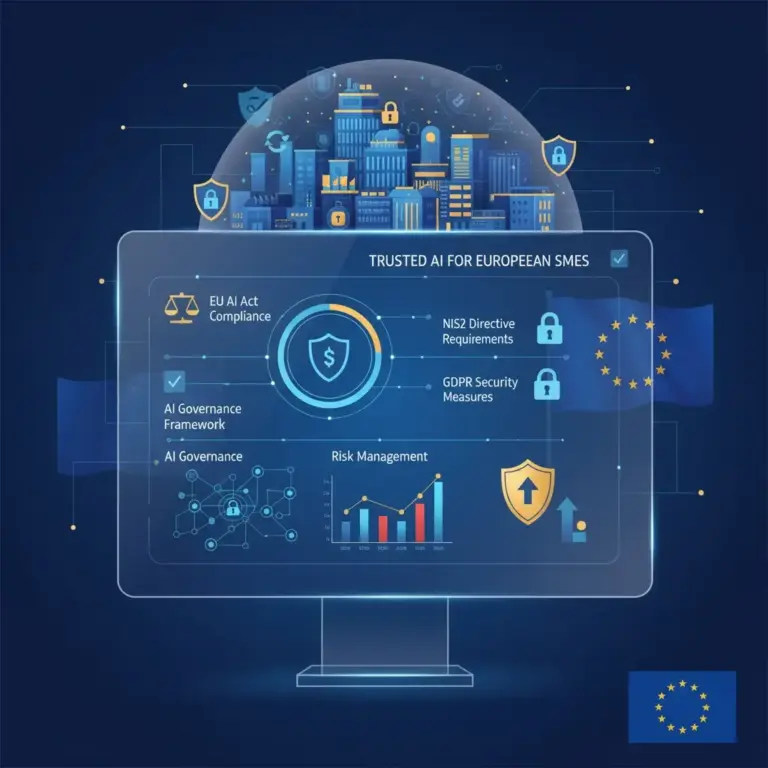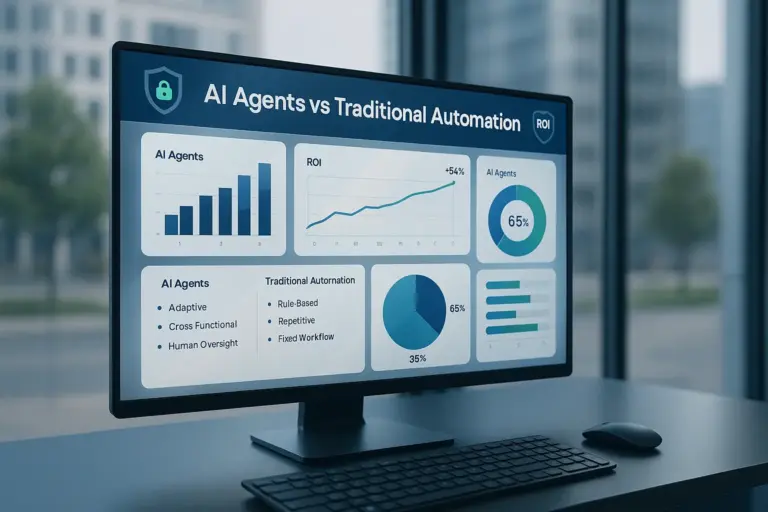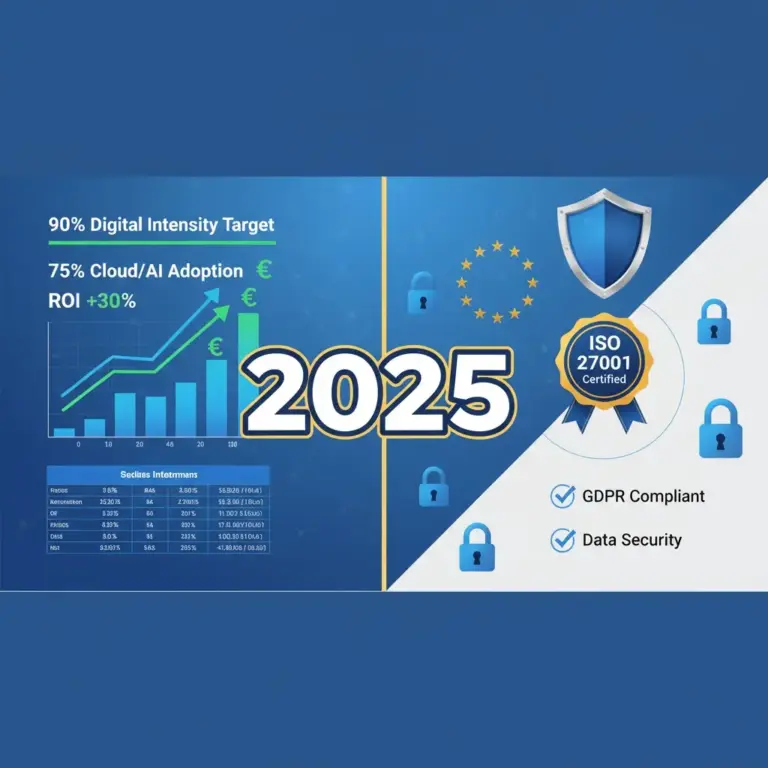AI Threat Detection for SMEs: Automated Cybersecurity Made Simple.
Introduction
Cyberattacks in 2025 are faster, more sophisticated, and more automated than ever. For small and medium-sized enterprises (SMEs), traditional security operations centers (SOCs) cannot keep pace. AI threat detection offers an intelligent, always-on defense that learns from data, correlates anomalies, and reacts instantly.
A single security analyst can now monitor thousands of endpoints through AI-driven alert prioritization and response automation. The result: reduced detection time, minimized false positives, and lower operational costs.
Table of Contents:
- Why AI Threat Detection Matters
- How AI-Based Threat Detection Works
- Top 5 Trends in Cybersecurity Automation
- Classic Security AI Solution
- Case Studies
- Implementation Roadmap
- Common Mistakes to Avoid
- FAQ
- Conclusion & CTA
- Metrics & Schema Summary
Why AI Threat Detection Matters?
The global cybersecurity landscape is shifting toward proactive defense. Manual log analysis and static rule sets cannot address polymorphic malware, social engineering, and insider threats. AI threat detection uses machine learning (ML) models to identify behavioral deviations and correlate signals across systems.
Key Benefits
- Speed: Average detection time reduced by up to 80%.
- Accuracy: Continuous learning minimizes false alarms.
- Cost Efficiency: Automates tier-1 SOC tasks, freeing human analysts for complex cases.
- Compliance: Logs every decision for GDPR, ISO 27001, and NIS2 audits.
According to IBM’s 2024 Cost of a Data Breach report, automation and AI reduced average breach costs by 30%. For SMEs, this translates into survival during an incident.
For more details on compliance, see /security.
How AI-Based Threat Detection Works:
- Data Collection: Network traffic, endpoint logs, and user behavior are continuously ingested.
- Feature Extraction: Relevant patterns are extracted—login times, access frequency, data transfer size.
- Model Training: Algorithms like Random Forest, Deep Neural Networks, and Isolation Forest learn normal vs. abnormal behavior.
- Real-Time Inference: Incoming data streams are scored against learned baselines.
- Response Automation: Confirmed anomalies trigger auto-containment, isolation, or alerts.
Classic Security integrates this workflow through its AI Security Engine, capable of 24/7 autonomous monitoring.
Top 5 Trends in Cybersecurity Automation:
1. AI-Driven SOC Automation
Security Operations Centers are integrating machine learning for alert correlation and automatic playbook execution. AI identifies duplicate alerts, merges incidents, and recommends next steps.
2. Generative AI for Threat Intelligence
Natural language models summarize intelligence feeds, highlight new attack vectors, and propose mitigation steps.
3. Predictive Defense Systems
Predictive analytics use historical breach data to forecast risk surfaces before attacks occur.
4. Zero Trust Integration
AI ensures continuous verification, analyzing behavior to validate identity and privilege dynamically.
5. Compliance-as-Code
Security policies (GDPR, NIS2, ISO 27001) are being codified into automated enforcement scripts, ensuring ongoing compliance without manual audits.
Classic Security AI Solution:
Classic Security’s AI Threat Detection Platform provides:
- Real-Time Detection: Monitors network and endpoint telemetry continuously.
- Automated Response: Quarantines endpoints or suspends credentials within milliseconds.
- Adaptive Learning: Refines detection models through feedback loops.
- Integration Ready: Works with existing firewalls, SIEM, and cloud platforms.
- Compliance Engine: Generates automated GDPR and ISO 27001 reports.
Pricing and deployment models are listed on /pricing.
Case Studies:
Case 1: Retail SME, Germany
Challenge: 10,000 daily logins and increasing phishing incidents.
Solution: AI threat detection deployed with behavioral analytics.
Result: Incident volume reduced 65%, detection time from 2 hours to 7 minutes.
Case 2: Logistics Provider, UK
Challenge: SOC overwhelmed by false positives.
Solution: SOC automation via Classic Security AI.
Result: Analyst workload down 45%, improved SLA compliance.
See more success stories at /case-studies.
Implementation Roadmap:
- Assessment: Identify current detection tools, log sources, and coverage gaps.
- Data Integration: Connect SIEM, endpoints, and cloud logs into the AI engine.
- Pilot Phase: Deploy in monitor-only mode, validate alerts and false positive rates.
- Full Rollout: Activate automated response rules.
- Audit & Optimize: Align detection and response to ISO 27001 Annex A controls.
Reference: ISO/IEC 27001 standard
Common Mistakes to Avoid:
- Ignoring data quality: poor input leads to missed threats.
- Over-reliance on AI: keep humans for validation.
- Neglecting compliance logs: GDPR mandates auditability.
- Deploying without change management: SOC teams need training.
- No KPIs: track Mean Time to Detect (MTTD) and Mean Time to Respond (MTTR).
FAQ
How does AI threat detection work?
It analyzes logs, behavior, and network traffic to identify anomalies using ML models.
What are the benefits of AI in cybersecurity?
Automation, accuracy, and 24/7 coverage. Reduces human fatigue and error.
Is AI threat detection reliable for SMEs?
Yes. Cloud-native AI models scale to SME data volumes with affordable pricing.
Does it replace analysts?
No. It augments them, handling repetitive tasks and surfacing critical incidents.
Is it GDPR and ISO compliant?
Yes. Classic Security embeds compliance logging, encryption, and retention policies.
Can AI prevent phishing or ransomware?
AI models detect behavioral patterns typical of phishing and isolate affected systems.
Learn more at /features or book a /demo.
Conclusion & CTA:
AI threat detection transforms cybersecurity from reactive to predictive. For SMEs, it enables enterprise-level protection at manageable cost. Automate, monitor, and respond before attackers strike.
➡ Next steps:
- Explore /features
- See pricing on /pricing
- Review our /security policies
- Request your /demo
- Get started today at /signup
- ENISA: AI in Cybersecurity
- NIST: AI Risk Management Framework
- MITRE ATT&CK Framework
- Harvard Business Review: How AI Is Transforming Cyber Defense
AI Agents for Business Automation
Agentic AI: The Future of Autonomous Systems
AI Risk & Compliance







